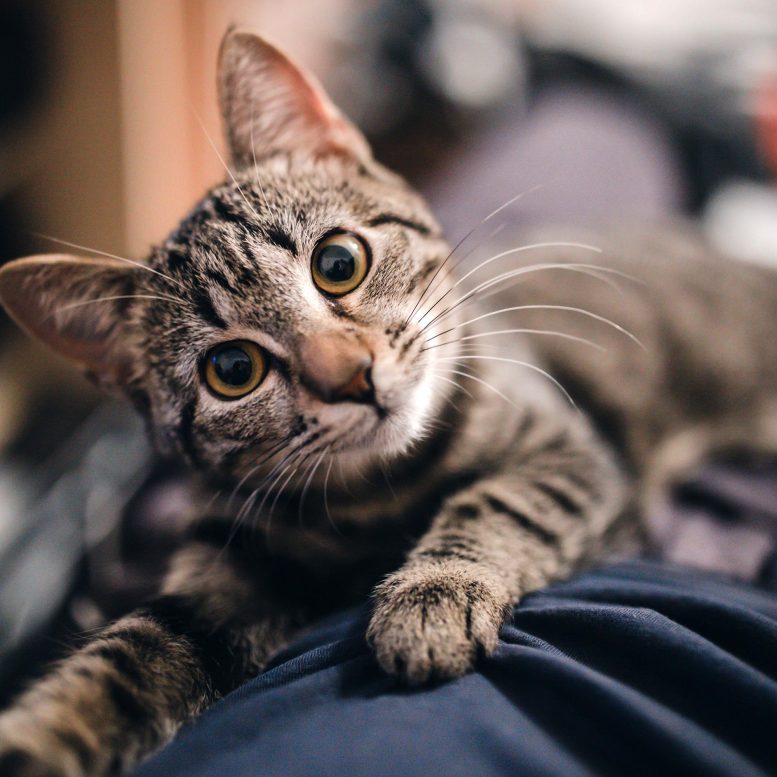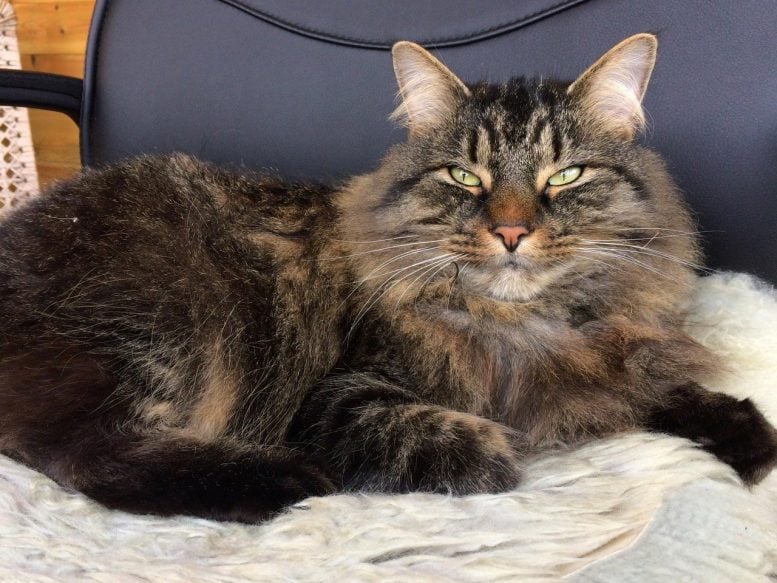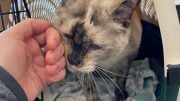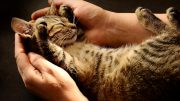
A recent study demonstrates that building rapport with a cat is possible by using an eye narrowing technique with them.
A team of psychologists at the Universities of Sussex and Portsmouth have purr-fected the art of building a bond with cats.
The new study, ‘The role of cat eye narrowing movements in cat-human communication,’ published online in the Nature journal Scientific Reports, has shown for the first time that it is possible to build rapport with a cat by using an eye narrowing technique with them.
This eye-narrowing action by humans generates something popularly known as a cat smile – the so-called “slow blink” – and seems to make the human more attractive to the cat. Eye narrowing movements in cats have some parallels with the genuine smile in humans (the Duchenne smile), as well as eye narrowing movements given in positive situations in some other species.
The team, led by Dr. Tasmin Humphrey and Professor Karen McComb, animal behavior scientists at the University of Sussex, undertook two experiments.

A Maine Coon cat demonstrating the narrowed-eye movement. Credit: Prof Karen McComb University of Sussex
The first revealed that cats are more likely to slow blink at their owners after their owners have slow blinked at them, compared to when they don’t interact at all.
The second experiment, this time with a researcher from the psychology team, rather than the owner, found that the cats were more likely to approach the experimenter’s outstretched hand after they’d slow blinked at the cat, compared to when they had adopted a neutral expression.
Taken together, the study shows that this slow blinking technique can provide a form of positive communication between cats and humans.
The study found:
- Cats were more likely to slow blink at their owners if their owners had slowed blinked at them, compared to when the owner was present in the room but not delivering a slow blink stimulus.
- Cats were more likely to slow blink when an unfamiliar experimenter slow blinked at them, compared to when they had maintained a neutral expression.
- Cats preferred to approach an experimenter after they had slow blinked at the cat than if they had maintained a neutral expression.
Professor Karen McComb, from the School of Psychology at the University of Sussex, who supervised the work, said: “As someone who has both studied animal behavior and is a cat owner, it’s great to be able to show that cats and humans can communicate in this way. It’s something that many cat owners had already suspected, so it’s exciting to have found evidence for it.
“This study is the first to experimentally investigate the role of slow blinking in cat–human communication. And it is something you can try yourself with your own cat at home, or with cats you meet in the street. It’s a great way of enhancing the bond you have with cats. Try narrowing your eyes at them as you would in a relaxed smile, followed by closing your eyes for a couple of seconds. You’ll find they respond in the same way themselves and you can start a sort of conversation.”
Dr. Tasmin Humphrey, a PhD student in the School of Psychology at the University of Sussex during the work, was the first author of the study. She said: “Understanding positive ways in which cats and humans interact can enhance public understanding of cats, improve feline welfare, and tell us more about the socio-cognitive abilities of this under-studied species.
“Our findings could potentially be used to assess the welfare of cats in a variety of settings, including veterinary practices and shelters.
“In terms of why cats behave in this way, it could be argued that cats developed the slow blink behaviors because humans perceived slow blinking as positive. Cats may have learned that humans reward them for responding to slow blinking. It is also possible that slow blinking in cats began as a way to interrupt an unbroken stare, which is potentially threatening in social interaction.”
Dr. Leanne Proops at University of Portsmouth, who co-supervised the work, said: “It’s definitely not easy to study natural cat behavior so these results provide a rare insight into the world of cat-human communication.”
How the experiments worked
Two experiments were conducted to explore the significance of the slow blink in cat–human communication.
The first experiment included a total of 21 cats from 14 different households. Fourteen different owners participated in experiment 1. Ten of the cats were male and 11 of the cats were female, with cat age ranging from an estimated 0.45–16 years. The experiments took place in each cat’s home. The psychologist advised the cat’s owner on how to slow blink. Once the cat had settled down in one place, the psychologist asked the owner to either sit approximately 1 m away from the cat.
Experiment 2 included a total of 24 additional cats. Twelve cats were male and 12 cats were female, with cat age ranging from an estimated 1–17 years old. The cats included in the final analyses were from eight different households. In this experiment, the researcher, who was unfamiliar to the cat, either slow blinked at the cat or adopted a neutral face without direct eye contact. This experiment also tested which context the cats preferred to approach the unfamiliar experimenter, by them offering the cat a flat hand with palm faced upwards whilst sat or crouched directly opposite the cat. Both experiments were video recorded.
Cat psychology – the existing context
In the new paper, the authors provide some context for their findings. The psychology of cats hasn’t been studied as extensively as dogs, but what is already known includes:
- That cats have been shown to attract and manipulate human attention effectively through ‘solicitation purring’.
- That cats can discriminate their name from other words, even when unfamiliar humans are calling.
- That cats may be sensitive to human emotional cues, and will rub or butt their head against an owner who feels sad.
‘The role of cat eye narrowing movements in cat-human communication’ by Tasmin Humphrey, Leanne Proops, Jemma Forman, Rebecca Spooner and Karen McComb, published in Scientific Reports, is open access.
Reference: “The role of cat eye narrowing movements in cat–human communication” by Tasmin Humphrey, Leanne Proops, Jemma Forman, Rebecca Spooner and Karen McComb, 5 October 2020, Scientific Reports.
DOI: 10.1038/s41598-020-73426-0









I’ve known that for nearly 40 years. I noticed it when I kissed at my cats from across the room and they would always give a slow blink back. I call their blink “kittie kisses”. I also do it to ferals I want to trap as to make them feel more comfortable with my presence.
I have a young tomcat, he blinks at me all the time. When I blink back I see his response of awareness. When i call for him, to come and eat he’s around in a couple minutes.
quite often I see “modern scientific experiments” with animal behavior, and I think “are these folks autistic?” They “eye-narrowing” works best when a complete blink is included, within a slow “narrowing” episode. Blinking, but not “narrowing” alone, also works with dogs that you have not met, as they are approaching you, and sometimes as you approach them; however, with a dog you have not met, simply breaking eye contact can also “relax” them – stare them in the eye, and it can be a “contest” or a “threat”.
My best friend in high-school bred my Black Lab. He told me cats are dumb: don’t know their name, won’t come when called, etc. I called my cat’s name, and she looked at me. I said “come here” and she did. (note that no, I never did this before, never “called” them for feeding time, etc.) My friend was astonished. Her sister knew when I was sad, and would come and sit in my lap and give me a “bath” (licking me like I was her kitten).
My two dogs could understand complex sentences (they spent more time with me, traveling in the car with me everywhere, etc.). It blew my mom and her boyfriend’s mind. I never simply gave them “command words” (except the word “OK” – which really had no specific meaning – it changed with the context of the situation and they always understood the intended meaning); I always talked to them in full COMPLEX sentences. Once, while cooking in the kitchen, my mom told me to put them outside because they were “underfoot”. I asked “If I can get them to stay in the other room while we cook, if that OK?” She looked at me like I was delusional. I never “trained” them to do such a thing – not even remotely like that. But I had learned how to COMMUNICATE with them. I simply said, in spoken English, “go lie down in the living room and wait until we finish cooking in here” while pointing to the living room. They immediately did just that and watched us until we were done. My mom was flabbergasted.
Training “pets” is what STUPID people do. They are stupid because they think they are “better” and their “pet” is dumb. Dumb is a lack of capability. Stupid is an inability or unwillingness to understand despite having the capability.
When a non-human life form is treated like a FRIEND and rapport is built, mammals and birds can communicate with each other both within a species and across species (recently “modern scientists” “confirmed” that creatures in the “wild” do just that, but as a “wilderness” hiker, that was old news to me), including with humans. It is the majority modern humans that have lost this ability, due to arrogance, I believe.
These are highly evolved creatures (cats, dogs, and more). No they don’t have language, don’t understand trigonometry, and don’t have opposing thumbs to help them build log houses with metal nails, but some are still smarter than some of the humans I know (Tuck Frump)
Oh, yea, forgot to add:
“pets” are “entertainment slaves”.
“friends” are “friends”.
(and sorry for the typos in the previous post)
Stupid me. I said “they don’t have language”. This is NOT a fact.
HUMANS don’t understand their language. It may be (is likely) far more simple than ours. I can tell something about what a cat wants by the type of “meow” it makes. Many an in-tune parent can also tell what thier baby needs by the “type” of crying it makes.
But these “sounds” that correspond to meaning do not nessesarily comprise a “language” in the sense of an “infinite open system with limits” that humans have – a system that can convey nearly any meaning.
However, in the case of birds, whales, dolphins, etc., humans have been trying to “understand” the “language of communication” between these creatures, with little to no success. Yet they (the ones held prisoner at Sea World, at least) can understand us when we speak!
Whose the good boy there?
good to know.